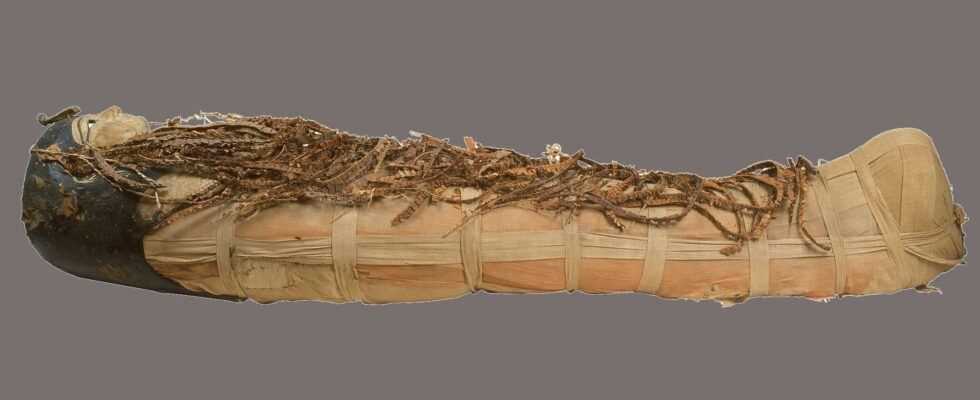The mummy of Pharaoh Amenophis I is probably one of the few Egyptian royal mummies that has not been unwrapped from its linen bandages for around 3000 years. Now researchers have found the corpse from the 16th century BC. X-rayed by computer tomography and thus made the body, the bandages and various amulets visible. As Sahar Saleem from Cairo University and the former Egyptian minister of antiquity, Zahi Hawass, write in the journal Frontiers in Medicine, the corpse showed some damage that had been restored in antiquity. In addition, the arms were probably once crossed on the chest. The mummy of Amenhotep I (also Amenhotep I) would be the oldest evidence of the typical arm posture of Egyptian royal mummies.
© S. Saleem / Z. Hawass (detail)
Mummy mask and skull | On the CT, Saleem and Hawass performed a profile cut through the mummy mask. Inside the skull of the pharaoh’s mummy can be seen.
With the help of the CT scans, radiologist Saleem and archaeologist Hawass made several observations: The pharaoh of the 18th Dynasty was probably around 35 years old at the time of his death. He was once 1.69 meters tall and circumcised. When he died, the king appears to have been physically sound and his teeth were in good condition. However, the researchers could not find the cause of death. As reported by other royal mummies of the early 18th dynasty, the embalmers did not remove either the heart or the brain. The intestines, in turn, were removed through an incision in the left flank of the body, and the abdominal cavity was then stuffed with linen. On and in the body as well as between the linen bandages, the researchers discovered a total of 30 amulets that were supposed to magically protect different parts of the body. There is a belt made of gold pearls around the waist.
The mummy showed some damage that was restored in ancient times. The severed head was reattached with a resin-soaked bandage. The left arm was also broken off. The later embalmers had placed it next to the upper body and fixed it with bandages. From the original position of the right extremity, the two researchers conclude that the arms were once crossed on the upper body. The right foot had also been torn off. The ancient Egyptian restorers supported it with a wooden board, wrapped both of them and nailed the board with bandages.
